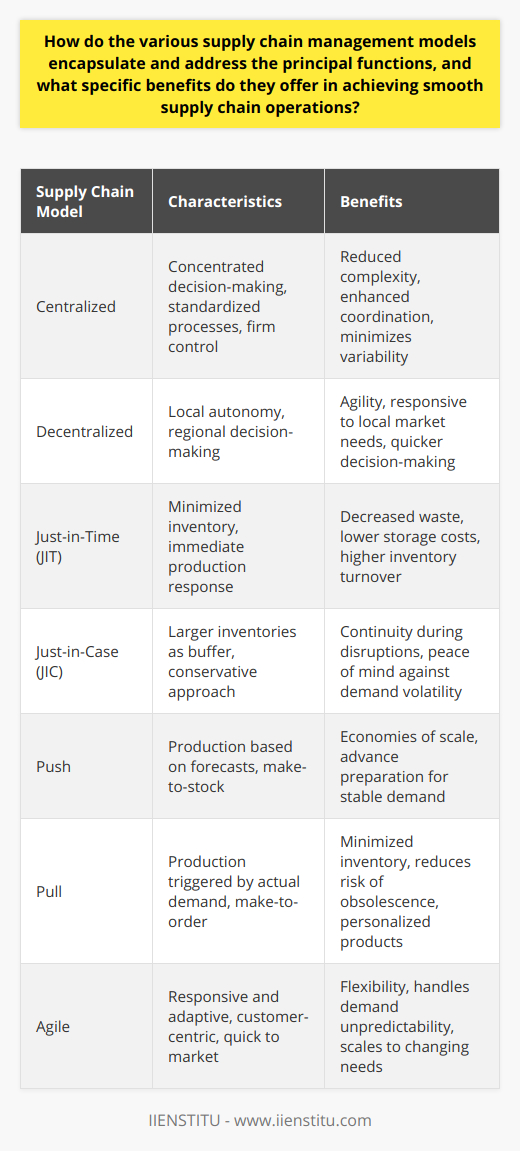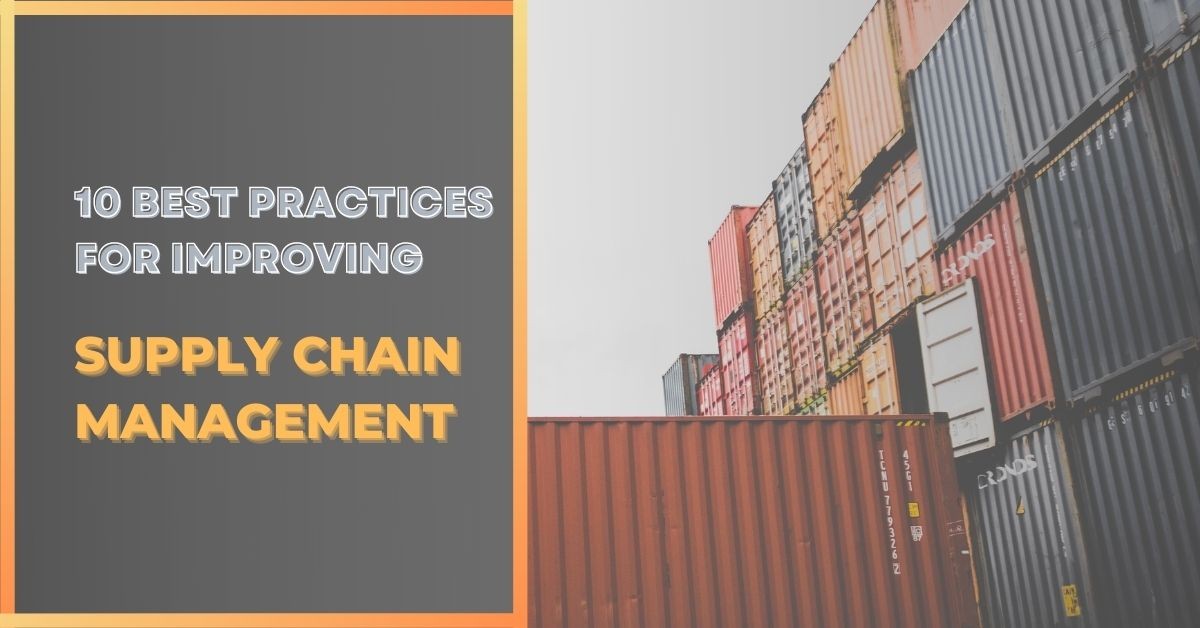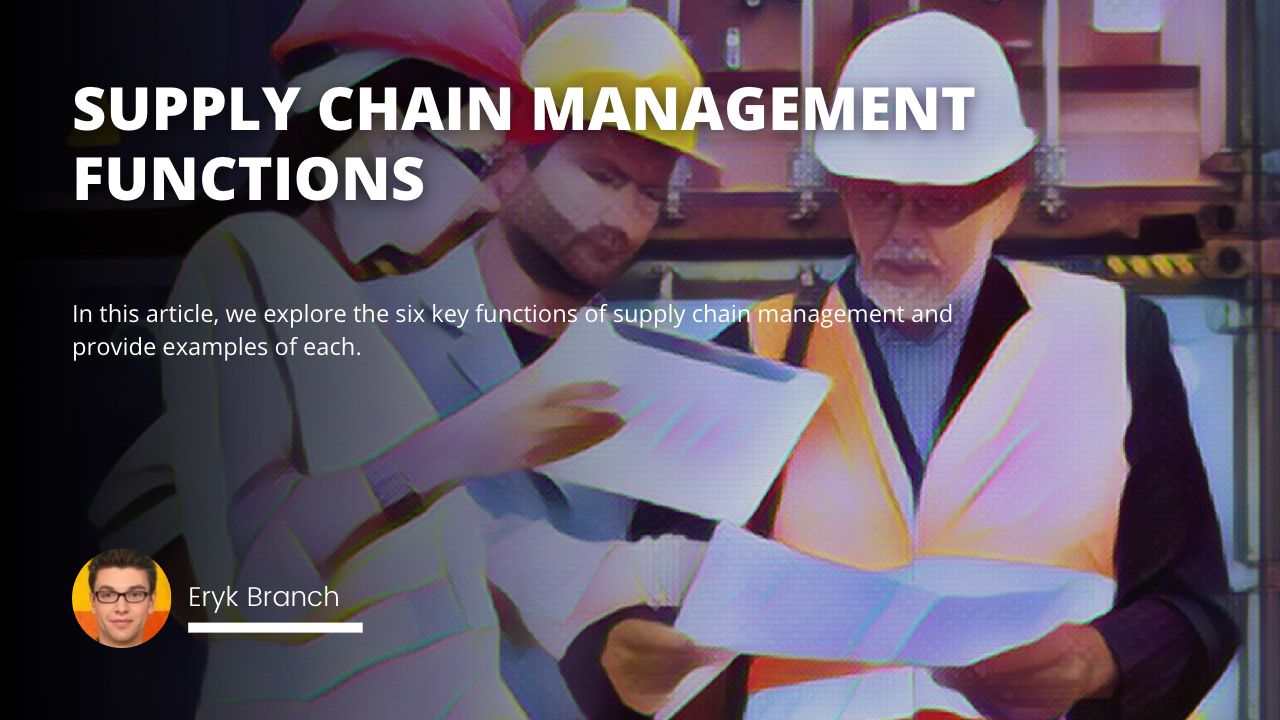
Supply chain management (SCM) is coordinating and managing all the different parts of a supply chain to ensure that goods and services are delivered on time, to the right place, and in the right quantities.
What is supply chain management, and what are its essential functions?
Procurement: sourcing and selecting suppliers
Production: ensuring goods are produced efficiently and meet quality standards
Logistics: getting products to the right place at the right time
Sales and marketing: promoting and selling products/services
After-sales service: providing support to customers once they have bought a product/service
Each of these functions is essential to the smooth running of a business, and they all need to be coordinated and managed to ensure that the supply chain runs smoothly.
If you're thinking of studying Supply Chain Management or working in Supply Chain Management, then it's essential to understand all the different functions involved. So read on to learn more about each of the essential Supply Chain Management functions.
Procurement: sourcing and selecting suppliers
The procurement function is responsible for sourcing and selecting suppliers. This involves finding potential suppliers, assessing their suitability, negotiating terms and conditions, and awarding contracts.
The procurement function is essential because it ensures that businesses only work with suitable suppliers who can provide goods or services that meet their needs at a competitive price. A well-run procurement function can also help to build strong relationships with suppliers, which can lead to better quality goods and services and improved delivery times.
How to select the best supplier for your organization?
The best way to select a supplier is to use a structured procurement process. This usually involves the following steps:
Define your requirements: what goods or services do you need, and what are your critical performance criteria?
Before you can begin evaluating potential suppliers, you need to understand your requirements clearly. What goods or services do you need, and what are your critical performance criteria? Once you have a good grasp of your needs, you can narrow down your search for the right supplier. There are several factors to consider when making your selection, including price, quality, delivery times, and after-sales service. By defining your requirements upfront, you can be sure that you find a supplier that can meet your needs and help your business succeed.
Search for suppliers: identify potential suppliers who can meet your requirements.
It is essential to identify those who can meet your specific requirements when sourcing suppliers. You will need to consider several factors, such as manufacturing capabilities, quality control, delivery times, and price. Once you have compiled a list of potential suppliers, you can narrow down your choices by contacting each one and requesting quotes. During this process, it is also essential to ask questions and feel for the supplier's level of service and customer support. By taking the time to vet your suppliers thoroughly, you can be sure that you choose a partner who can help you meet your goals and grow your business.
Evaluate suppliers: assess each supplier against your criteria to shortlist the best ones.
Regardless of the industry, assessing and selecting suppliers is crucial for any business. The goal is to find suppliers that can provide high-quality goods or services at a reasonable price and who will be able to meet your company's needs in a timely and efficient manner. There are several factors that you'll need to take into account when evaluating suppliers. First, you'll need to consider the quality of the products or services they provide. It's also important to look at turnaround time, flexibility, and customer service. Once you've gathered this information, you'll be better positioned to make an informed decision about which supplier is right for your business.
Negotiate contracts: negotiate terms and conditions with your chosen supplier/s.
When it comes to negotiating contracts, it is essential to be clear about your objectives and to have a good understanding of the other party's position. Start by identifying the key terms and conditions that are most important to you, and then be prepared to compromise on other less critical issues. It is also important to remember that the other party is likely to be just as concerned about their interests as yours, so try to approach the negotiations in a cooperative rather than adversarial manner. If you can reach a fair and mutually beneficial agreement, then everyone will be happy with the outcome.
Award contract: award the contract to your chosen supplier/s.
Now that you've chosen your supplier, it's time to award the contract. This can be a formal or informal process, depending on the size and scope of the project. In most cases, you'll need to issue a purchase order to the supplier, outlining the terms of the agreement. Once the supplier accepts the purchase order, the contract is official. Make sure you keep a copy of the contract on file to refer back to it if there are any questions or issues that arise. Congratulations! You've just taken an important step toward completing your project.
Manage contract: manage the contract throughout its duration, and monitor supplier performance.
Managing a contract effectively requires regular monitoring of the supplier's performance. This allows the buyer to identify any issues or problems early on and take corrective action if necessary. It also allows the buyer to assess whether the supplier is meeting the contract terms and identify any areas where they may be falling short. Furthermore, monitoring supplier performance can help to improve the buyer's negotiating position when it comes time to renew the contract. By taking these steps, buyers can ensure that they get the best possible value for their money.
Factors to consider when making a final decision
Quality of products or services
Turnaround time
Flexibility
Customer service
Price
Production: ensuring goods are produced efficiently and meet quality standards.
The production function ensures that goods are produced efficiently and meet quality standards. This involves planning production, scheduling work, monitoring progress, and controlling costs.
The production function is essential because it ensures that businesses can produce goods or services quickly and cost-effectively. A well-run production function can also help to improve the quality of products and services and reduce waste.
Logistics: getting products to the right place at the right time
The logistics function is responsible for getting products to the right place at the right time. This involves planning and managing the transportation of goods and storage and distribution.
The logistics function is essential because it ensures that businesses can get their products or services to customers quickly and efficiently. A well-run logistics function can also help to reduce costs, improve customer service, and reduce waste.
Sales and marketing: promoting and selling products/services
The sales and marketing function is responsible for promoting and selling products or services. This involves developing marketing campaigns, identifying potential customers, negotiating contracts, and closing deals.
The sales and marketing function is essential because it helps businesses increase revenue by selling more products or services. A well-run sales and marketing function can also help build relationships with customers and generate leads for other parts of the business.
After-sales service: providing support to customers once they have bought a product/service
The after-sales service function is responsible for providing support to customers once they have bought a product or service. This involves dealing with customer queries and complaints, providing technical support, and arranging repairs or replacements.
The after-sales service function is essential because it helps businesses keep their customers happy and loyal. A well-run after-sales service function can also help resolve problems quickly and efficiently and reduce the number of returns.
If you are looking to learn more about supply chain management, we have the perfect course. The Supply Chain Management course covers all of the key topics mentioned in this blog post. You will learn how to identify and select suppliers, produce goods efficiently and meet quality standards, get products to the right place at the right time, promote and sell products/services, and provide support to customers once they have bought a product/service. Enroll now and gain the skills you need to effectively manage your company's supply chain!
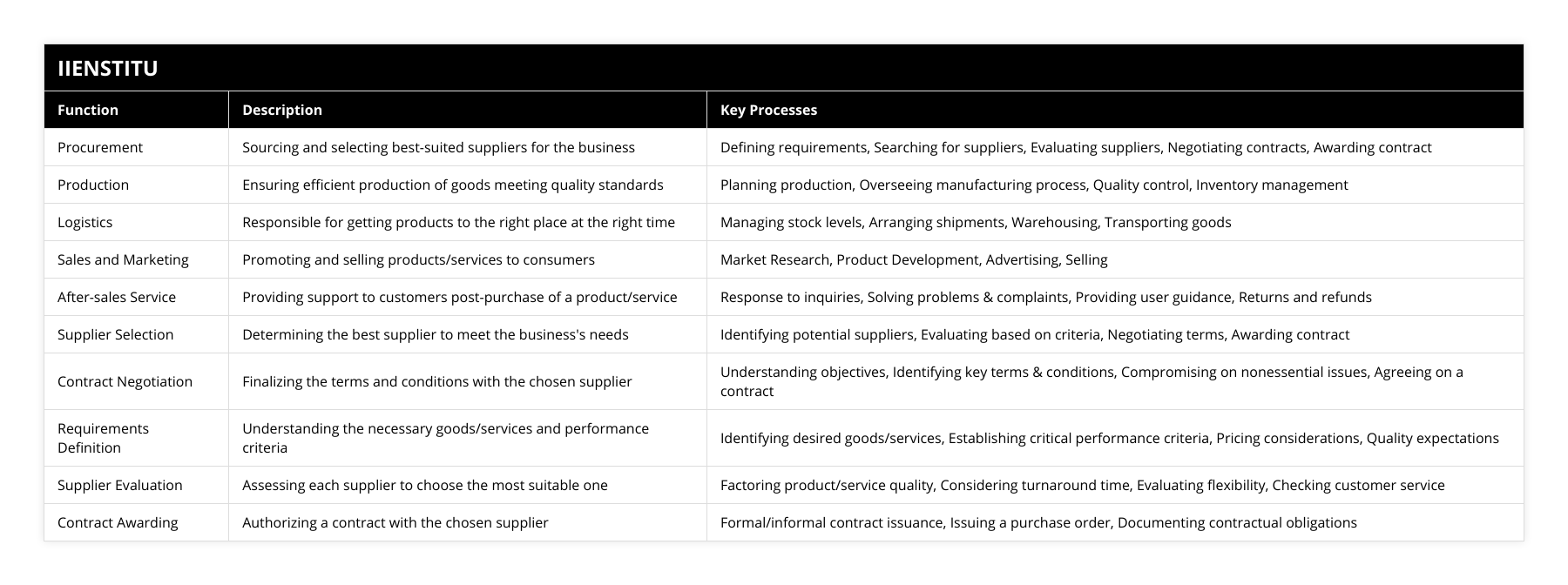
The report extensively discusses the various functions of supply chain management (SCM) including procurement, production, logistics, sales and marketing, as well as after-sales service. Each function plays a key role in the smooth flow of a business operation. Interestingly, the report also comprehensively explains the procurement function, detailing requirements definition, supplier search, supplier evaluation, contracts negotiation, and contracts awarding. All these processes are crucial for organizations to streamline their operations and meet their needs at competitive prices. Therefore, studying or working in SCM necessitates a thorough understanding of these functions. For individuals interested in this field, supply chain courses online free can offer further in-depth knowledge and skills.
Frequently Asked Questions
What are the 7 essential functions in a supply chain management system?
**Supply Chain System Functions**
In a supply chain management system, seven essential functions contribute significantly to ensuring optimal operations and meeting the needs of customers. These functions play a vital role in managing the flow of goods and services along the supply chain, maintaining efficiency and providing a competitive advantage.
**Demand Planning**
Demand planning involves forecasting customer demand for products and services, which helps companies to make informed decisions regarding production, inventory, and distribution. Accurate demand planning allows businesses to meet customer needs efficiently while minimizing costs and maximizing profits.
**Sourcing and Procurement**
Sourcing and procurement involve identifying, selecting, and managing suppliers responsible for providing raw materials, components, or finished goods. This function helps in reducing costs, ensuring timely deliveries, and maintaining strong relationships with suppliers to guarantee product availability and quality.
**Production and Conversion**
The production and conversion function encompasses the processes needed to transform raw materials, parts or components into finished products or services. Production planning, scheduling, and quality control are essential elements in this function, ensuring that firms can deliver goods and services on time and according to customer expectations.
**Inventory Management**
Inventory management focuses on the storage, movement, and tracking of raw materials, work-in-progress items, and finished goods. Efficient inventory management ensures the right quantity of goods is available at the right location and time, consequently reducing costs, preventing stockouts, and enhancing customer satisfaction.
**Logistics and Transportation**
Logistics and transportation deal with the efficient movement of products along the supply chain. This includes shipping, warehousing, and distribution of products. The primary goal of this function is to ensure timely delivery of goods, minimize costs, and enhance the overall responsiveness of the supply chain system.
**Customer Service**
Customer service involves addressing and fulfilling customer needs, requests, and complaints. In supply chain management, it includes order management, product returns, and delivery tracking. Providing superior customer service contributes to customer satisfaction, brand loyalty, and long-term customer retention.
**Supply Chain Coordination**
Supply chain coordination ensures the seamless integration of all functions and activities across the supply chain. It involves communication, collaboration, and monitoring between supply chain partners. Effective coordination enables businesses to optimize operational efficiency, reduce lead times, improve responsiveness, and enhance overall supply chain performance.
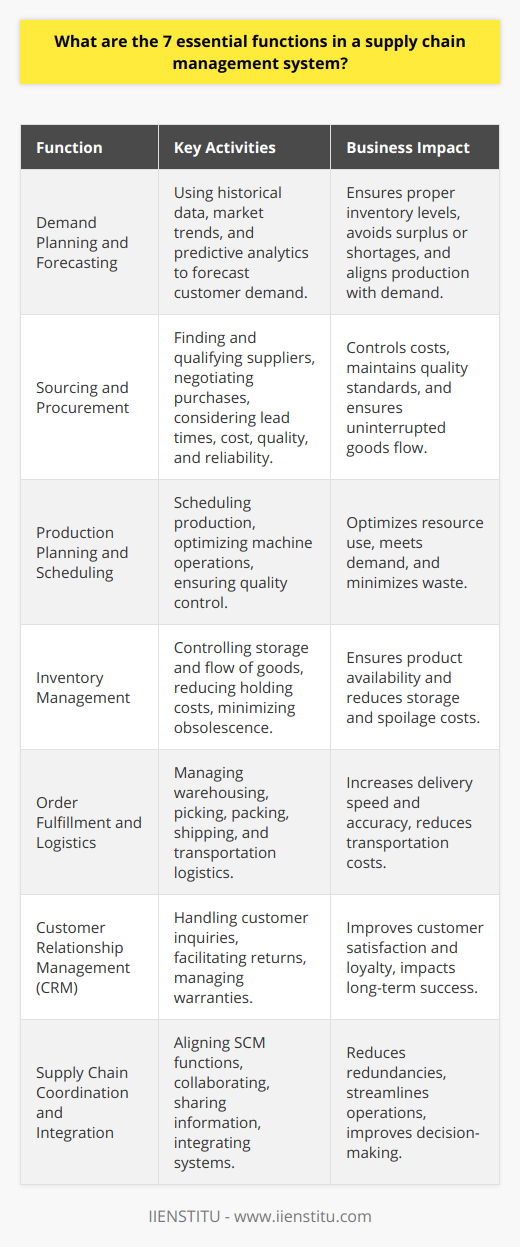
How do the main functions of supply chain management contribute to achieving a company's objectives?
**Efficient Coordination of Activities**
The main functions of supply chain management (SCM) contribute to achieving a company's objectives by efficiently coordinating activities. It harmonizes the supply and demand sides, allowing the company to satisfy customer needs while optimizing resource usage. This strategic approach increases competitiveness and ensures long-term success.
**Effective Flow of Information**
Effective communication and information flow are integral to successful SCM. It ensures real-time data exchange between all stakeholders, promoting transparency and timely decision-making. Accurate and up-to-date information empowers companies to make informed decisions about inventory, production, and distribution, thereby streamlining processes and improving overall performance.
**Cost Reduction and Resource Optimization**
SCM's primary goal is to reduce costs and optimize resource utilization. By implementing effective procurement, transportation, and warehousing strategies, companies can avoid unnecessary expenses and eliminate bottlenecks in their supply chains. Proper inventory management also prevents stockouts and overstocking, leading to significant cost savings and enhanced customer satisfaction.
**Risk Management and Mitigation**
An essential function of SCM is to identify, assess, and mitigate risks associated with the supply chain. This proactive approach enables companies to minimize disruptions in their operations or adjust quickly to unprecedented events. By effectively managing risks, organizations can maintain the stability and continuity of their supply chains, thereby safeguarding their long-term objectives.
**Enhanced Customer Satisfaction**
SCM's primary focus is to meet customer needs and expectations by ensuring product quality and timely delivery. Effective supply chain management allows companies to predict customer demand and make necessary adjustments to their production and distribution processes. This adaptability enables businesses to maintain a continuous flow of goods, resulting in increased customer satisfaction and loyalty.
**Continuous Improvement and Sustainability**
Supply chain management encourages continuous improvement and sustainability, both of which are vital for achieving a company's objectives. By adopting environmentally responsible and socially conscious practices, organizations can maintain a positive image and adhere to regulatory requirements. Moreover, as businesses strive for improvement, they can capitalize on market opportunities and enhance their overall efficiency and profitability.
In conclusion, the main functions of supply chain management, including efficient coordination of activities, effective information flow, cost reduction, risk management, and customer satisfaction, significantly contribute to achieving a company's objectives. These functions work together to create a streamlined, efficient, and sustainable supply chain that can adapt to the ever-changing business landscape, ensuring long-term success and competitiveness.
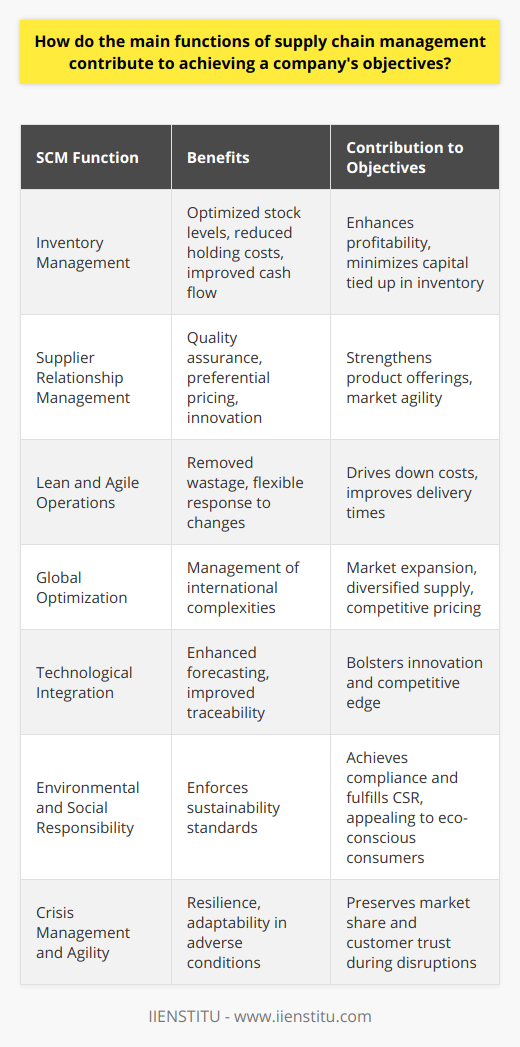
Can you explain the importance of the 6 primary supply chain management functions?
Supply Chain Management Functions
Supply chain management (SCM) is a critical aspect of modern business operations, encompassing the planning, management, and execution of an organization's entire supply chain. The primary supply chain management functions are: procuring raw materials, optimizing transportation, managing inventory levels, handling warehouse operations, developing a product offering, and delivering it to the consumer.
Procurement of Raw Materials
The first function, procurement, involves the acquisition of goods and services necessary for the smooth functioning of the supply chain. It ensures the timely and cost-effective procurement of raw materials, components, and services to maintain uninterrupted production.
Transportation Optimization
Effective transportation is essential for the efficient movement of goods within the supply chain. This function involves selecting the optimal mode of transportation, analyzing routes, and monitoring third-party logistics providers to ensure prompt and cost-effective delivery of products.
Inventory Management
Inventory management involves maintaining the optimal levels of inventory throughout the supply chain in order to meet customer demands. It entails monitoring stock levels, assessing safety stock, and managing reorder points to maximize profitability and minimize stockouts.
Warehouse Operations
Managing warehouse operations is a key function of SCM, focusing on organizing, controlling, and monitoring the storage and movement of goods within a warehouse. This includes appropriate allocation of storage space, ensuring the efficient movement of products, and maintaining accurate records of inventory.
Product Development
In the context of SCM, product development refers to the design, development, and production of goods that meet market demands. It involves continuous innovation, research, and collaboration among different stakeholders to ensure a competitive product offering.
Order Fulfillment
Finally, order fulfillment is the process of ensuring prompt and accurate delivery of products to customers. This function involves activities such as order processing, packaging, billing, and shipping, all aimed at meeting customer expectations and maintaining their satisfaction.
In conclusion, the six primary supply chain management functions play a vital role in streamlining business operations and improving overall efficiency. By effectively implementing these functions, organizations can ensure optimal inventory levels, reduced costs, and increased customer satisfaction, ultimately leading to higher profitability and market competitiveness.
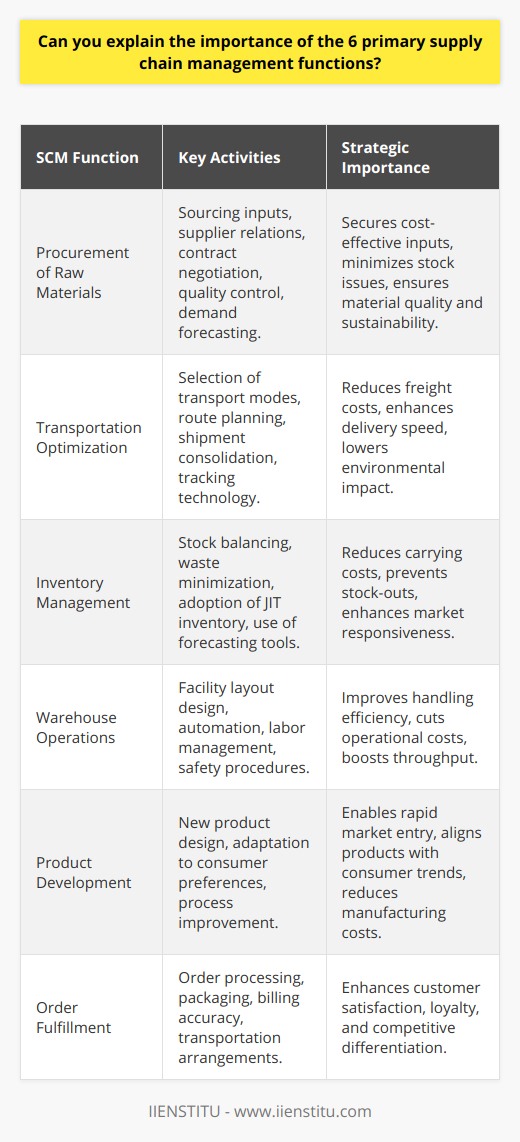
What are the key components and processes within the 5 main functions of supply chain management?
**Supply Chain Planning**
The first key component within the main functions of supply chain management is supply chain planning. This involves determining the optimal approach to meet customer demand, while minimizing costs and maximizing efficiency. Processes include demand forecasting, inventory management, and materials requirements planning, which aid in creating production schedules and allocating resources accordingly.
**Sourcing and Procurement**
Sourcing and procurement are essential components of supply chain management, as they involve the selection of suppliers and the acquisition of raw materials, components, and services from them. Key processes include supplier evaluation, contract negotiation, and purchase order management, which ensure that materials are obtained at the most favorable terms and meet the required quality standards.
**Production and Manufacturing**
The production and manufacturing stage encompass the transformation of raw materials into finished goods. This process involves various functions, such as quality assurance, production scheduling, and process engineering, to ensure that products are produced efficiently and meet customer specifications. Moreover, a lean manufacturing approach can be employed to optimize resources and minimize waste, ultimately improving the overall production process.
**Distribution and Logistics**
Distribution and logistics involve the storage and transportation of finished goods from the manufacturing facilities to the customers. Key elements include warehouse management, inventory control, and transportation management, which aim to ensure that products are stored safely, efficiently, and delivered on time. Moreover, employing effective distribution strategies, such as cross-docking, can enhance the overall efficiency of the supply chain.
**Customer Service and Returns Management**
Lastly, customer service and returns management play an essential role in maintaining customer satisfaction and ensuring a successful supply chain management process. This component involves handling customer inquiries, processing orders, and resolving issues related to returns and refunds. Efficient returns management is vital, as it reduces the costs associated with reverse logistics, improves customer satisfaction, and promotes customer retention.
In conclusion, the key components and processes within the main functions of supply chain management include supply chain planning, sourcing and procurement, production and manufacturing, distribution and logistics, as well as customer service and returns management. Implementing effective practices and strategies within each of these areas can significantly improve the overall performance of the supply chain, ensuring customer satisfaction and enhancing competitiveness within the market.
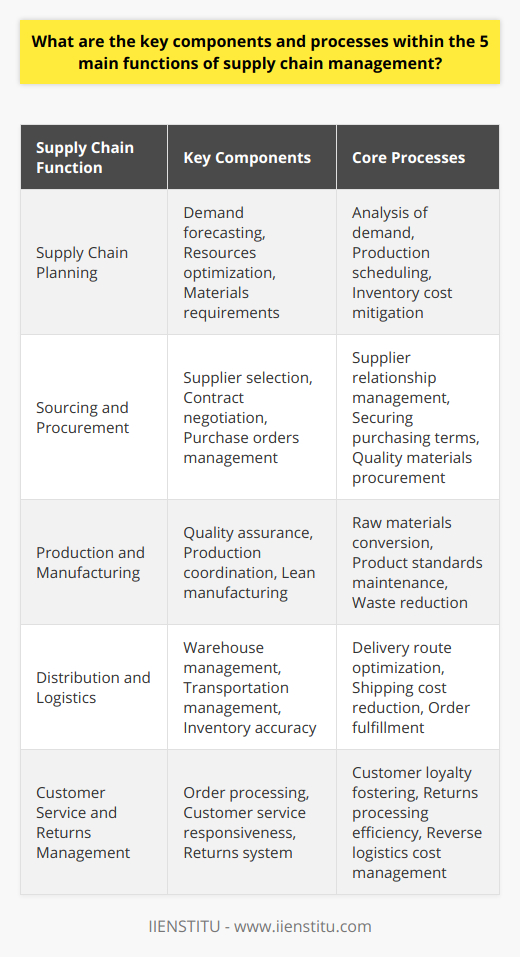
How do the 7 core supply chain functions collectively contribute to the efficiency and effectiveness of a supply chain?
Core Supply Chain Functions and Their Collective Contribution
**1. Demand Planning**
Demand planning plays a critical role in ensuring supply chain efficiency by facilitating accurate forecasts of customer needs, reducing inventory and improving customer satisfaction. By analyzing historical sales data and considering factors like seasonality, promotions and market trends, it helps organizations to make informed decisions about production and distribution.
**2. Sourcing and Procurement**
Innovative sourcing and procurement strategies enhance supply chain effectiveness by lowering costs and reducing lead time. This aspect involves selecting and managing suppliers, negotiating contracts, and establishing long-term relationships, which in turn assures quality products and services that are delivered in a timely manner.
**3. Production and Manufacturing**
Efficient production and manufacturing processes are vital for an effective supply chain, as they ensure the smooth transformation of raw materials into finished goods ready for sale. By minimizing waste, controlling costs and adopting lean manufacturing principles, organizations can optimize production processes that support high-quality products without delays.
**4. Inventory Management**
Proper inventory management techniques enable supply chain efficiency by balancing levels of stock against production and customer requirements. By closely monitoring inventory levels and using strategies like just-in-time (JIT) or vendor-managed inventory (VMI), organizations can minimize stockouts, reduce stock holding costs and improve cash flow.
**5. Warehousing and Storage**
Efficient warehousing and storage operations ensure products are inventoried, tracked and maintained properly, thus contributing to the effectiveness of a supply chain. By implementing warehouse management systems (WMS) and employing best practices like cross-docking or zone picking, organizations can optimize the storage and retrieval of products, facilitating faster order fulfillment.
**6. Transportation and Distribution**
An efficient transportation and distribution network is key to a high-performing supply chain, as it impacts delivery speed and product availability. This involves selecting the most appropriate mode of transportation and optimizing routes, which can lead to reduced transportation costs, improved on-time delivery, and increased customer satisfaction.
**7. Customer Service**
Providing excellent customer service, which includes processing returns and addressing complaints, is crucial for maintaining a sustainable and effective supply chain. Ensuring a smooth customer experience allows organizations to build a positive reputation, enhance customer loyalty, and potentially attract new customers.
In conclusion, the seven core supply chain functions collectively contribute to its efficiency and effectiveness by ensuring accurate demand forecasting, cost-effective sourcing, optimized production, streamlined inventory management, effective warehousing and storage, efficient transportation, and excellent customer service. By addressing these core functions, organizations can maximize their supply chain's potential, leading to increased profitability and a competitive advantage in the marketplace.
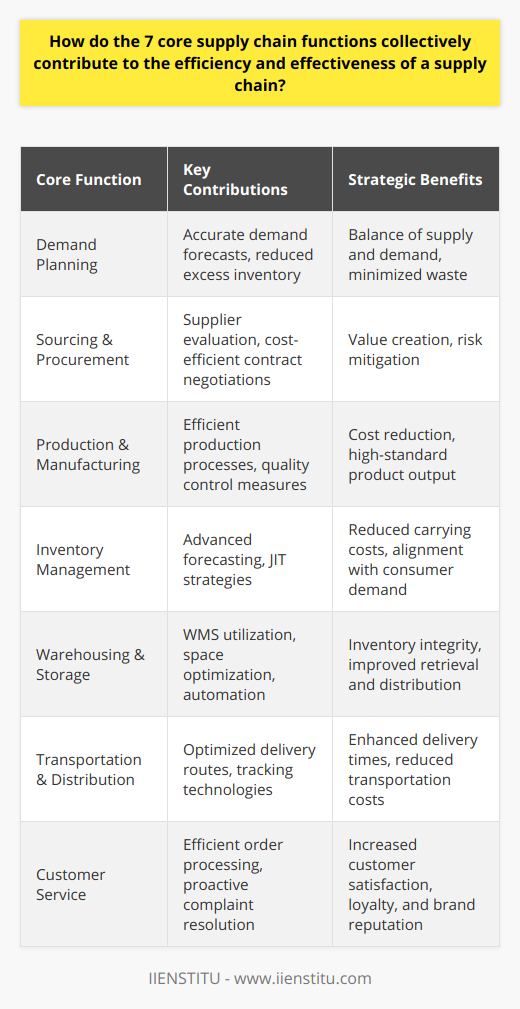
In the context of the 3 primary functions of supply chain management, how do these functions interrelate and optimize an organization's logistics and operations?
Interrelation of Primary Functions
To optimize an organization's logistics and operations, supply chain management (SCM) plays a crucial role by focusing on three primary functions: procurement, logistics, and operations management. These functions interrelate to create efficient systems that ultimately drive organizational success and amplify its overall performance.
Procurement's Impact on Logistics and Operations
Procurement, the process of obtaining goods and services, serves as the foundation of effective SCM. Robust procurement strategies ensure that an organization acquires high-quality resources at competitive prices while mitigating supply-related risks. By sourcing the best materials and suppliers, procurement paves the way for smooth logistics and operations by establishing long-term, cost-effective relationships with reliable partners.
Synergy between Logistics and Operations Management
Logistics, the process of moving goods throughout the supply chain from the suppliers to the consumers, heavily relies on the efficiency of procurement and operations management. An organization's capacity to streamline its logistics directly affects the performance of its operations. For instance, efficient logistics ensure timely deliveries, minimal waste, and reduced transportation costs, ultimately leading to optimal performance within the organization's operations management.
Additionally, operations management - which focuses on planning, organizing, and controlling the production and distribution of goods - is interdependent on both procurement and logistics. Efficient operations require readily available resources and a seamless transportation system. By streamlining procurement and logistics, organizations can optimize operations management, ensuring that goods are produced and distributed effectively.
Optimization through Collaboration
The success of an organization's logistics and operations lies in the close collaboration of procurement, logistics, and operations management. By integrating these primary functions and focusing on effective communication, organizations can build a resilient and agile supply chain that adapts and thrives in a dynamic business environment. Synchronized and data-driven decision-making processes across these three areas not only optimize operational efficiency but also enable organizations to anticipate and respond to market fluctuations and customer demands more effectively.
In conclusion, the interrelationship and synergy between procurement, logistics, and operations management are indispensable for any organization that aims to optimize its logistics and operations. By fostering close collaboration and alignment among these primary functions, organizations can build resilient supply chains that drive success and growth in an increasingly competitive global market.

What are the fundamental differences between the 7 supply chain functions and the 7 C's of supply chain management?
Differentiating Supply Chain Functions
The seven supply chain functions include purchasing, operations, distribution, integration, scheduling, transportation, and performance measurement. Each of these functions defines a specific operation that ensures the successful delivery of goods along the supply chain - from the initial procurement of raw materials to the final delivery of products to consumers.
Understanding the 7 C's of Supply Chain Management
In contrast, the seven C's of supply chain management, coined by Douglas Lambert, provide a strategic approach to managing relationships along the supply chain. The seven C's are namely: connection, communication, collaboration, cooperation, coordination, credibility, and culture. These principles act as guidelines to foster relationships and efficient communication among the entities involved in the supply chain to facilitate smoother operations.
Contrasting Differences
One key difference between the two concepts lies in their focus. The functions focus primarily on the technical operations, while the 7 C's steer towards fostering relationships and ensuring seamless communication among various entities in the supply chain.
In the seven functions, tasks like purchasing and transportation are tangible. They involve specific activities that integrate the entire process of moving goods from the producers to the consumers.
On the other hand, the 7 C's are more intangible as they revolve around relationship-oriented aspects. These include building connections and fostering a culture of collaboration and cooperation among the stakeholders.
In conclusion, although both concepts are essential for an effective supply chain, they serve different purposes. The seven functions facilitate the physical movement of goods, while the 7 C's aim to build efficient communication and collaborative relationships among entities in the supply chain.

How do the three key functions of supply chain management play a role in achieving operational excellence and ensuring customer satisfaction?
Efficient Product Flow
The first primary function of supply chain management is to ensure an efficient flow of products. Proper management of the sources of supply and acceleration of production processes facilitates timely delivery of products. This process competitiveness aids in achieving operational excellence by minimizing costs, improving product quality, and reducing delivery times. Consequently, customers receive their orders promptly and in excellent condition, leading to high customer satisfaction.
Streamlined Information Flow
The second key function is the effective flow of information. Seamless communication across every element of the supply chain is crucial. It allows for better planning, coordination, and control of supply chain activities. With effective information flow, supply chain management can foresee potential disruptions and promptly respond, ensuring operational continuity. Hence, customers remain confident in the company's reliability, boosting their overall satisfaction.
Financial Flow Optimization
The third function focuses on the financial flow within the supply chain. Efficient supply chain management strategizes to reduce costs and enhance the value of products or services. By doing so, companies can offer competitive pricing, which plays a significant role in attracting and retaining customers. Additionally, companies can invest saved funds into improving product quality and service delivery, directly contributing to customer satisfaction.
Overall, the integration of these three functions of supply chain management—efficient product, information, and financial flow—enhances operational excellence. Better operations result in high-quality products delivered on time at reasonable prices, ensuring customer satisfaction. Therefore, effective supply chain management is vital for the success of any business.

What specific tools and strategies can businesses use to optimize the four basic supply chain functions and drive improvement across the entire supply chain?
Forecasting and Demand Planning
The ability to predict customer demands is crucial for optimal supply chain function. Businesses can utilize data analysis software and artificial intelligence for forecasting. These tools analyze historical data, market trends, and customer buying behaviors to help predict future needs.
Warehousing and Inventory Management
Warehousing and Inventory management relate to the storing and tracking of goods. Companies can use warehouse management systems (WMS) to monitor inventory levels. This WMS can optimize storage space, decrease the time required to pick and pack orders, and improve order accuracy.
Transportation Management
Companies can optimize transportation through fleet management systems. These digital platforms allow companies to optimize routes, ensure compliance to delivery schedules and reduce transportation costs. Transportation and fleet management solutions provide real-time tracking and analytics.
Procurement and Supplier Relationship Management
Building good supplier relationships is important for an effective supply chain. Companies can use supplier relationship management (SRM) tools. SRM tools help maintain quality standards, negotiate better terms, and manage contracts. Moreover, companies should incorporate efficient procurement strategies. These strategies can include centralized buying, utilizing e-procurement tools, and establishing long-term supplier contracts.
Continuous improvement strategies
Businesses should aim for continual supply chain improvements. Companies can run regular audits and reviews to identify areas for improvement. Lean, Six Sigma, and Total Quality Management (TQM) methodologies can help streamline and improve all aspects of a supply chain.
In conclusion, businesses can optimize the four basic supply chain functions using a combination of digital tools and efficient strategies. These strategies foster improvement across the supply chain.

What are the critical distinctions and overlaps between the 5 main functions and the 3 primary functions of supply chain management?
Functions of Supply Chain Management
Supply chain management (SCM) has both main and primary functions. Five main contexts in SCM comprise planning, sourcing, creating, delivering, and returning. Conversely, three primary functions are purchasing, operations, and logistics.
Main and Primary Functions Distinctions
The critical distinction is, the main functions offer a comprehensive view of supply chain processes. Planning is all about managing resources to meet demand. Sourcing entails choosing suppliers providing needed materials. Creating incorporates the production or manufacturing of products. Delivering covers the sale and transport of items to consumers. Returning handles defective products, excess, and the management of recyclable materials.
Primary functions, on the other hand, concern daily SCM activities. Purchasing ensures supply meets production needs. Operations convert materials into finished goods. Logistics coordinate the flow of goods from production to consumers.
Functional Overlaps
The overlaps lie in how these functions interact to achieve efficient SCM. For instance, selecting suppliers (sourcing) touches on purchasing, a primary function. The creation stage involves operations while delivery corresponds to logistics.
In conclusion, while the main and primary functions have distinct roles, they share overlapping logical sequences. Effectively syncing these functions contributes heavily to ideal supply chain management. Understanding these distinctions and overlaps is essential for managers to optimally run the supply chain, ensuring smooth workflow and enhanced productivity.

In terms of the 7 C's of supply chain management, how do they relate to and enhance the efficiency of the 7 fundamental supply chain functions?
Understanding the Connection
To analyze how the 7 C's of supply chain management relate to the 7 fundamental supply chain functions, it is essential to realize the connectivity. The 7 C's (Connectivity, Communication, Collaboration, Coordination, Chain of Custody, Control, and Continuation) exist to enhance the performance of the 7 fundamental supply chain functions: Planning, Information, Source, Make, Deliver, Return, and Enable.
Connection to Planning and Information
The efficiency of planning and information in supply chain functions hinges on the connectivity, communication, and collaboration. These three C’s ensure that all participants in the supply chain have consistent contact and shared understanding of their roles and expectations. This improves overall planning and aids in the quick and accurate exchange of information.
Connection to Source, Make, and Deliver
In terms of the source, make, and deliver functions, coordination, chain of custody, and control assume a prominent role. Coordination ensures tasks are carried out effectively and seamlessly in the sourcing, manufacturing, and delivering process. Chain of custody guarantees product integrity, reinforcing trust among supply chain partners. Control keeps all processes in check, ensuring a highly functional system.
Connection to Return and Enable
When considering the return and enable functions, continuation becomes critical. It sustains the ever-adaptive nature of supply chains, allowing for improvement and development. This, in turn, allows for efficient management of returns and the innovative enablement of supply chain procedures.
In Conclusion
Through such interconnectivity, the 7 C's effectively elevate the 7 fundamental supply chain functions. Therefore, a keen focus on each of these C's allows for an efficient, well-managed, and high-performing supply chain. The strength of this relationship underscores the strategic importance of understanding and implementing the principles of the 7 C's in the realm of supply chain management.

How do the various supply chain management models encapsulate and address the principal functions, and what specific benefits do they offer in achieving smooth supply chain operations?
Centralized and Decentralized Models
Centralized supply chain management models concentrate on central control of all supply chain activities. The benefit is the creation of a standard procedure that eliminates redundancy, reduces costs, and improves efficiency. On the other hand, decentralized models distribute control over different supply chain departments. Such a model provides flexibility, promotes innovation, and tailors solutions to local demands.
Just-in-Time and Just-in-Case Models
Just-in-time models focus on timely delivery of products, reducing or eliminating inventory maintenance costs. Similarly, just-in-case models, with surplus inventory stored for unanticipated demand, ensure continued operation during market volatility. Each model, however, comprehensively addresses principal functions while pre-empting potential issues.
Push and Pull Models
Push models predict consumer demands and accordingly decide production. It reduces chances of surplus product but risks mismatching demand. Conversely, pull models initiate production upon receiving customer orders, reducing risks of surplus but posing challenges in sudden demand spikes. Both models, therefore, bestride a balance of efficiency and responsivity.
Agile Supply Chain Model
The agile model combines aspects of both pull and push models. It responds to actual customer demands, while having a planned supply of materials. This dual function not only offers flexibility to handle fluctuating demands but also contributes to faster operations and cost reduction.
Undoubtedly, each supply chain management model encapsulates principal supply chain functions in its unique manner. Their contextual application can bring specific benefits, including cost reduction, operational efficiency, demand responsiveness and versatility. Therefore, businesses need to judiciously align their commercial demands with appropriate models for streamlining operations.
